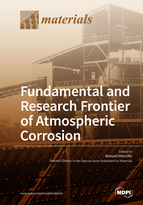Fundamental and Research Frontier of Atmospheric Corrosion
A special issue of Materials (ISSN 1996-1944).
Deadline for manuscript submissions: closed (28 February 2017) | Viewed by 70176
Special Issue Editor
Special Issue Information
Dear Colleagues,
Atmospheric corrosion has been extensively researched over the last one hundred years, and, as a result the effects of meteorological variables and pollution on atmospheric corrosion, are now quite well known. Even so, our knowledge of this issue still holds many gaps, such as how to accurately estimate the total time of wetness of metallic surfaces, the effects of climate change and acid rain, and the corrosion mechanisms that act in chloride-rich and marine-industrial atmospheres; the latter being particularly important in less developed countries where factories are often located in coastal regions.
For engineers and political policy-makers it is fundamental to be able to predict atmospheric corrosion well into the future (25, 50, 100 years). Data mining and modelling tools can help to improve atmospheric corrosion forecasts and anti-corrosive designs, but despite great progress in the development of damage functions (dose-response) in wide-scale international cooperative research programmes there is still a way to go for such long term modelling of atmospheric corrosion processes. Nonetheless, in some highly developed countries efforts are now being made to design civil structures such as bridges and other load-bearing structures for 50–100 years of service without any maintenance.
Finally, mankind is concerned about the degradation , restoration and conservation of its historic heritage. The effects of atmospheric corrosion on old buildings and structures, statues and monuments, etc., have resulted in substantial degradation of artistic and historic objects.
For this Special Issue, we invite authors to publish research articles or comprehensive reviews on the topics referred to above.
Prof. Dr. Manuel Morcillo
Guest Editor
Manuscript Submission Information
Manuscripts should be submitted online at www.mdpi.com by registering and logging in to this website. Once you are registered, click here to go to the submission form. Manuscripts can be submitted until the deadline. All submissions that pass pre-check are peer-reviewed. Accepted papers will be published continuously in the journal (as soon as accepted) and will be listed together on the special issue website. Research articles, review articles as well as short communications are invited. For planned papers, a title and short abstract (about 100 words) can be sent to the Editorial Office for announcement on this website.
Submitted manuscripts should not have been published previously, nor be under consideration for publication elsewhere (except conference proceedings papers). All manuscripts are thoroughly refereed through a single-blind peer-review process. A guide for authors and other relevant information for submission of manuscripts is available on the Instructions for Authors page. Materials is an international peer-reviewed open access semimonthly journal published by MDPI.
Please visit the Instructions for Authors page before submitting a manuscript. The Article Processing Charge (APC) for publication in this open access journal is 2600 CHF (Swiss Francs). Submitted papers should be well formatted and use good English. Authors may use MDPI's English editing service prior to publication or during author revisions.
Keywords
- climate, time of wetness, climate change
- aerosols, particle induced corrosion
- chloride-rich atmospheres, de-icing salts
- impact of atmospheric corrosion on the environment (runoff)
- prediction, modelling
- degradation and conservation of cultural heritage
- weathering steels, copper (alloys), etc.
- surface coatings
- worldwide atmospheric corrosion research
- new analytical techniques







